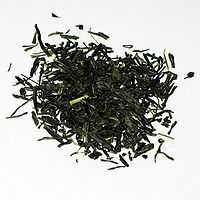Gyokuro
 | |
| Type: | Green |
| Other names: | 玉露, jewel dew / jade dew / pearl dew / precious dew |
| Origin: | Japan |
| Quick description: | Considered one of the highest grades of tea available in Japan. |
Gyokuro (Japanese: 玉露, "jade dew") is a type of shaded green tea from Japan. It differs from the standard sencha (a classic unshaded green tea) in being grown under the shade rather than the full sun. Gyokuro also differs from another shaded tea called kabusecha (lit., "covered tea"), in the length of time it undergoes the final growth under the shade (gyokuro is shaded for approximately three weeks, while kabusecha is shaded for approximately one week[1]). The name "gyokuro" translates as "jewel dew" (or "jade dew", referring to the pale green colour of the infusion). While most sencha is from the Yabukita (薮北) cultivar of Camellia sinensis, gyokuro is often made from a specialized variety such as Asahi, Okumidori, Yamakai, and Saemidori.
Preparation
Merchants selling Japanese green tea typically recommend a unique method for brewing gyokuro which differs from typical tea brewing:
- use twice the weight in dry tea leaves for a given quantity of water (e.g. 6 to 10 grams for 180 ml, or 2 to 3 heaping teaspoons for 2 small cups);
- use a lower brewing temperature (in the range of 50°C–60°C (122°F–140°F) instead of 65°C–75°C (149°F–167°F) for sencha; for high-end Gyokuro such as National tea jury rank, a temperature of 40°C (104°F) is recommended.);
- a longer steeping duration, at least for the first infusion (90 seconds instead of 1 minute for sencha).
Since gyokuro is typically steeped at such a low temperature, sources may recommend preheating both the pot and cup to maintain the warmth of the tea as one drinks it.
Cultivation
Though it is categorized as a type of sencha according to production methods, gyokuro cultivation differs from other sencha teas. Gyokuro tea leaves are shielded from the sun for at least two weeks before being harvested. This causes both the amino acid theanine and the alkaloid caffeine in the tea leaves to increase, which yields a sweet flavour.[2] The tea also gains a distinct aroma from the covering process. This type of cultivation is also used in producing tencha, (碾茶) but records indicate this process had already been developed in the Azuchi-Momoyama period.
Market
Gyokuro is one of the most expensive types of sencha available in Japan. The name comes from the product name given to the tea by the Yamamotoyama Tea Company. The tea was first discovered by Yamamotoyama's sixth owner, Yamamoto Kahei, in 1835 (Tenpō year 6). The process was completed by another manufacturer at the start of the Meiji period.
The greatest appellation of gyokuro is Yame in Fukuoka Prefecture in terms of both quality and quantity. More than 40% of gyokuro is produced in Yame, and in the national tea jury in August 2007, gyokuro of Yame held all the ranking positions from first to 26th as the best gyokuro.[3] The Uji district is the oldest gyokuro-producing region in Japan.
Gyokuro should not be confused with "tamaryokucha", a tea produced in the Kyushu region. Tamaryokucha also has a sweet flavour, but its production process differs from that of gyokuro.
See also
- List of Japanese teas
References
| ||||||||||||||||||||||||||||||||||||||||||||||||||||||||||||||